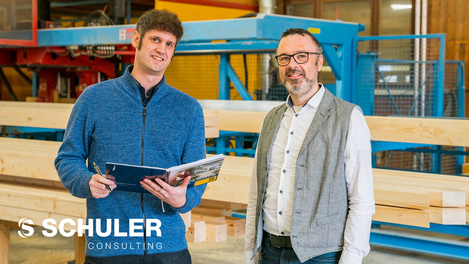Shaping the prospects of timber construction together.
An interview on serial refurbishment from the perspective of timber construction companies.
Timber construction and its market segments are currently experiencing a structural change. Many timber construction companies are no longer primarily active in the single-family home construction sector and are instead branching out into other sectors. These include multi-story buildings, modular timber construction, extensions or the renovation of existing buildings. Serial renovation is an increasingly popular topic among timber construction companies. Matthias Schlosser, Managing Director of the ZimmerMeisterHaus (ZMH) Group and Dr. Stefan Bockel, Head of Product Management at WEINMANN, discuss the work of ZMH and the emerging opportunities and challenges of serial renovation for woodworking shops.
The ZimmerMeisterHaus (ZMH) Group consists of around 100 German timber construction companies and aims to encourage its members to share their knowledge and experience, thus helping them to position their companies in the best possible way. With a strong focus on marketing, experts, knowledge and products, ZMH has become a well-known professional network in the new construction, extension, residential and commercial construction sectors. Members benefit not only from the many years of experience and expertise of their peers, but also from a broad network of experts and market partners.
Mr. Schlosser, please could you briefly introduce yourself and tell us a little about the history of ZMH?
Matthias Schlosser (MS): I have been Managing Director of the ZMH Group for three years. Before this, I was on the Executive Board of ZMH for 26 years. The group was founded in 1987 by 17 timber construction companies who joined forces to promote timber house construction. ZMH has made a significant contribution to the development of timber house construction over the last three decades.
You have already mentioned the change in the timber construction industry in recent years. How has the awareness of customers regarding timber construction changed in recent years?
MS: First and foremost, we have to spend far less time persuading customers to choose timber construction, since many of them are already aware of its advantages. Being able to provide our products and services even more efficiently makes timber construction even more attractive to end customers. Furthermore, customers expect a certain degree of efficiency, for example through the use of trained specialists or, above all, a reduction in bureaucracy. I think we're on the right track here.
As the focus on sustainability and energy efficiency continues to increase, it is not only the construction of new buildings that has changed — the renovation of existing buildings has changed too. What are the main reasons your member companies have for getting involved in serial renovation?
MS: It is a question of preserving the value of a building, because serial renovation is a sustainable form of value enhancement. A "house-in-house" solution offers a much higher level of quality than merely covering an outer wall with full thermal insulation. This allows us to maintain and even increase the value of the building structure.
In addition, we are able to implement these solutions more quickly.
Mr. Bockel, are there any other parties who are interested in increasing the value of the building structure aside from the end customers and wood construction companies?
Stefan Bockel (SB): It is certainly also an important topic from a banking perspective: If large sums are invested in renovation, determining whether this will increase the value or is merely for maintenance is crucial.
Mr. Schlosser, do you see any other positive aspects of serial renovation besides energy efficiency and value preservation?
MS: One big advantage is that serial renovation is particularly attractive to end customers thanks to support from legislators. This provides major incentive for our companies to be active in this segment. Serial renovation is not only more efficient, but also more socially acceptable and less stressful for tenants, because the elements, including windows, are mounted on the existing building over just a few days.
In your opinion, what opportunities does serial renovation offer your members? How is this different from the process for new construction?
MS: The greatest opportunity lies primarily in the development of an additional business area. What's more, this segment may compensate for the decline in
the single- and two-family home segment, since large volumes are involved in the serial renovation sector. Especially when it comes to supporting tenants, the process of serial renovation differs from new construction projects as the buildings are occupied. If, for example, the heating systems are being renovated in addition to the facade, craftsmen must also enter the apartments — for serial renovation this therefore requires completely different concepts and different construction site management. Active construction site communication with the customer's on-site contact should also be a priority.
What skills do your member companies need to successfully carry out serial renovation?
MS: To successfully implement serial renovation, having the relevant expertise is of fundamental importance — a prerequisite that all our member companies fulfill. Although there does not appear to be much difference in the manufacture of exterior walls in serial renovation when compared to conventional residential construction, the digital integration of building technology poses specific challenges for larger order volumes. To achieve greater cost-effectiveness, more intensive discussion is therefore required. As such, companies should always deal with the digital recording of the buildings. Some companies can already handle this internally, while others can purchase these services from selected partners to secure an optimal position in the serial renovation sector.
Mr. Bockel, what role do you think automation plays in serial renovation?
SB: The relevance of CNC machining in the serial renovation sector should not be overlooked, as it encourages effective prefabrication and can meet the highest quality requirements. It is also important to note that elements for new buildings can be produced using the same technology. This means that manufacturers not only have a wider portfolio, but can also make better use of their own systems. The topic of work preparation is also highly relevant from the manufacturer's point of view, as it ensures that project-specific requirements can be prepared and automatically processed to the greatest possible extent.
Mr. Schlosser, how much potential do you think automation has for serial renovation?
MS: Automation could certainly further optimize serial renovation processes and tap into the potential of the sector. Regarding the use of CAD (computer-aided design) programs, there are only a few obstacles in this sector that would prevent the effective use of these technologies. As soon as the elements have been drawn up and the machine data has been generated, it is fundamentally irrelevant whether the elements are used for a normal house or a serial renovation. In this context, however, it is important to remember that successful implementation is largely dependent on construction site management and project management expertise.
In addition to opening up a new market segment and the increasing attractiveness of the serial renovation method, companies also have to deal with new processes and structures in the production process. What obstacles do businesses have to overcome in the serial renovation sector?
MS: Over the last ten years, the timber construction industry has developed considerably, especially in the area of apartment construction. This trend continues, but we also need appropriately qualified specialists to meet market demand. This is why it is essential to nurture new talent and to adapt training to current market developments, which requires the participation of schools, universities and higher education. In addition, technologies for increasing efficiency should be standardized. Another important political aspect is the different state building regulations across the federal states of Germany, which creates additional bureaucracy in the construction sector. As a result, I hope that this will become more standardized in the future.
At present, the construction of single- and multi-family homes is on the decline. In your opinion, how important is the serial renovation segment for your member companies in the current market circumstances?
MS: In my opinion, it is important to take advantage of the opportunities that arise. Every company has an opportunity to build a further foothold by opening up a new business sector, regardless of whether this sector is a replacement for a discontinued segment or not. Nevertheless, it is important that our members adapt to this specific market segment and win over the right customers because they have the expertise and knowledge to meet the requirements of this market segment.
SB: Serial renovation is a hot topic at the moment, with small and medium-sized projects in particular being implemented. It offers woodworking shops the opportunity to widen their portfolios and to counteract any market fluctuations in the new building sector more effectively. Another interesting aspect is the current development of renovation specialists in the market. However, the transformation of existing buildings deserves greater political focus, as sustainable construction methods for new and existing buildings are vital in order to meet societal demands for increased climate protection.
What recommendations would you make for companies that want to progress in this sector?
MS: I believe that it is very important to ensure good organization within the company, with which, for example, membership of ZMH can help. Our manufacturers thrive on discussing their experiences and benefit enormously from the expertise within the group. To avoid possible mistakes and ensure an efficient company structure, this point should be a priority in my opinion. To promote the exchange of experiences, we proactively invite our member companies to meetings where colleagues talk about their experiences and share valuable insights. This practice has proven to be very valuable and is an exclusive offering made possible by ZMH organizing project groups and experience exchange groups (Erfas).
How do you both see the short- and medium-term market developments in relation to serial renovation?
MS: As a participant in this industry, I consider the developments to be extremely positive. Wood as a renewable raw material has now become very appealing to customers. There is also a significant market for the energy-efficient renovation of older buildings. Under these conditions, I am not worried at all. The ZMH Group is well-networked and, thanks to the organized exchanges, forms the foundation for everyone to profit on the market.
SB: From my perspective, there will be strong growth in the volume of small and medium-sized renovation projects in particular. Major construction projects will also increase due to the development of specialists. Furthermore, I can definitely imagine this segment being served by woodworking shops as well as by some specialized industrial companies in the future. The increase in value and sustainable construction methods will certainly promote timber construction, but we also need to leverage further potential for efficiency in the industry so that we can become even more competitive in comparison to conventional insulation systems and take on a greater volume of the market.








